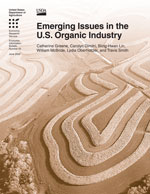Since the late 1990s, U.S. organic production has more than doubled, but the consumer market has grown even faster. Organic food sales have more than quintupled, increasing from 3.6 billion US Dollars in 1997 to 18.9 billion US Dollars in 2007. More than two-thirds of U.S. consumers buy organic products at least occasionally, and 28 percent buy organic products weekly, according to the Organic Trade Association. This fast-paced growth has led to input and product shortages in organic supply chains, and several new issues — concern about premium-priced product sales in a tight U.S. economy, as well as competition from new environmental labels — are emerging in the organic industry.
A recent report by the Economic Research Service ERS of the United States Deparment of Agriculture analyses the current status of organic agriculture in the US. The study drew on a range of ERS studies and surveys on organic production and handling, and conducted an extensive literature review to better characterize the U.S. organic sector.
The main finding are:
- Significant price premiums, fast-paced growth in demand, and fluctuating market conditions have characterized the U.S. organic sector since the beginning of the decade. Early in the decade, demand for organic products outpaced supply, and market participants reported that a supply squeeze was limiting growth in the overall sector.
- More recently, U.S. organic producers and manufacturers have had to contend with the impact of a weaker U.S. economy on organic food sales. Surveys suggest that many organic consumers may not be particularly sensitive to the price premium paid for organic products. While frequent buyers of organic products may not change their organic purchasing habits even with the current economic slowdown, infrequent buyers may limit their purchases of organic products, and the rate of gain for new organic consumers may decline.
- The low organic adoption rate for grain crops continues to be a bottleneck for expansion of the U.S. organic livestock sector, as organic livestock producers struggle to fi nd reliable sources of affordable feed grains. Only 0.2 percent of U.S. corn and soybean crops were grown under certified organic farming systems in 2005, according to ERS estimates.
- Organic imports have increased as U.S. demand for organic products has exceeded domestic supply. USDA-accredited groups certified 27'000 producers and handlers worldwide to the U.S. organic standard in 2007, with approximately 16'000 in the United States and 11'000 in over 100 foreign countries.
- Organic handlers reported relying primarily on domestic suppliers in 2004, although 38 percent imported some or all of their organic products.
- At the retail level, organic produce and milk, the two top organic food sales categories, receive significant price premiums over conventionally grown products. ERS analyzed organic prices for 18 fruits and 19 vegetables using 2005 data on produce purchases, and found that the organic premium as a share of the corresponding conventional price was less than 30 percent for over two-thirds of the items.
- Organic food costs more to produce and also commands significant price premiums at the farm level. According to recent ERS analysis of national dairy and soybean survey data, total economic costs were signifi cantly higher for organic dairy and soybean operations than for conventional operations. With an average price premium of 6.69 US Dollars per hundredweight for organic milk, organic milk producers covered most of the additional costs of organic production in 2005.
- Organic producers also face competition from new labels like the “locally grown” label. USDA organic regulations define organic production as an ecological production system that fosters cycling of resources, promotes ecological balance, and conserves biodiversity, but the regulations do not address where organic farmers market their products.
- According to an ERS survey of organic handlers, 24 percent of organic sales in 2004 were made locally (within an hour’s drive of the handlers’ facilities) and another 30 percent were made regionally. Partly in response to organic supply shortages, Congress in 2008 boosted funding for organic research and for a certifi cation cost-share program in the Food, Conservation, and Energy Act. Congress also made conservation practices related to organic production and transition eligible for payments of up to a 20'000 US Dollar annual limit, with an 80'000 US Dollar cap over a 6-year period, under the Environmental Quality Incentives Program (EQIP).
Source: Summary of the Report Emerging Issues in the U.S. Organic Industry.
Further information
Report quote
Greene, Catherine , Carolyn Dimitri, Biing-Hwan Lin, William McBride, Lydia Oberholtzer, and Travis Smith: Emerging Issues in the U.S. Organic Industry. Economic Information Bulletin No. (EIB-55) 36 pp, June 2009
Documents
Report homepage
Report summary
Abstract, Contents, and Summary
Entire Report
Organic World
Organic-World-Net: United States

 tap and then scroll down to the Add to Home Screen command.
tap and then scroll down to the Add to Home Screen command.